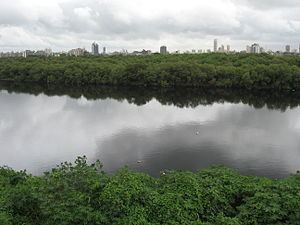Country India | ||
 | ||
- location Aarey Colony, Goregaon (E) | ||
Citizens voice saving mumbai s mithi river
The Mithi River (a.k.a. Mahim River) is a river on Salsette Island, the island of the city of Mumbai, India. It is a confluence of tail-water discharges of the Powai and Vihar lakes. The river is seasonal and rises during the monsoons. The overflowing lakes also contribute to the river flow, which is stopped by a dam at other times. During this season, the river is a favourite with anglers, who can catch large fish that have escaped from the lakes. Fishing is banned there. The international airport is located right next to the section of river at Andheri.
Contents
- Citizens voice saving mumbai s mithi river
- Map of Mithi River Mumbai Maharashtra
- Sweet mithi river
- Geography
- Ecology
- Environmental degradation
- Cleanup
- Development
- References
Map of Mithi River, Mumbai, Maharashtra
Sweet mithi river
Geography
The river originates from the overflow of Vihar Lake and also receives the overflows from the Powai Lake about 2 km later. It flows for a total of 15 km before it meets the Arabian Sea at Mahim Creek flowing through residential and industrial complexes of Powai, Saki Naka, Kurla, Kalina, Vakola, Bandra-Kurla complex, Dharavi and Mahim. The river has an average width of 5 metres in the upper reaches, has been widened to 25 m in the middle reaches and up to 70 m in the lower reaches after the 26 July 2005 deluge (944 mm in 24 h on 26 July 2005).
Ecology
It is also less well known that the Mahim bay area, where Mithi River meets Arabian Sea is a nominated bird sanctuary where migratory birds come for nesting. This part is full of mangroves. When the river was not as polluted as it is today, it used to serve as an important storm water drain for Mumbai but as it has been used as a sewer over the years, its importance as a storm water drain has reduced and on the contrary, it poses as a hazard during high tide bringing polluted water into the city and flooding the city.
Environmental degradation
The river has been polluted by dumping of raw sewage, industrial waste and municipal waste into the river. Besides this, illegal activities like washing vessels, animals and oily drums, discharge of unauthorised hazardous waste are also carried out along the course of this river. Cattle sheds in some areas contribute animal waste. Barrel cleaners, scrap dealers and others dump sludge oil, effluent and garbage in the river. The organic waste, sludge and garbage dumping has reduced the carrying capacity of the river. The water with mixture of sewage and industrial waste is a threat to marine life. The river bed is full of sludge, garbage and vegetation growth like water hyacinth in many parts.
The city of Mumbai earned the epithet - 'Cottonopolis of India' due to its vibrant cotton textile mills. The mills over the years have utilized water from this river and dumped their waste into it leading to the present polluted state of the river.
Cleanup
The Municipal Corporation of Greater Mumbai has undertaken a cleanliness drive lately so that the floods of July 26, 2005 are not repeated. An environmental group has been formed by Rajendra Singh, an award-winning conservationist in 2009. The BMC has been able to remove just 2.67 lakh cubic metres so far, or 60% of what is required. It aims to revive the dying river.
Development
Many young entrepreneurs in and around Mumbai are now aggressively involved with cause of Mithi River, and creating awareness on a global scale as the government of India has once again started ignoring this extremely important issue. In 2009, environmentalist and Magsaysay Award winner, Rajendra Singh lead a yatra, of a group of environmentalist and NGOs, through Mumbai city along the endangered Mithi river to highlight its problems.
Recently a Contemporary Art show was held to create major awareness about dire situation of Mithi River in Bombay by "Chintan Upadhyay" titled Khatti - Mithi
